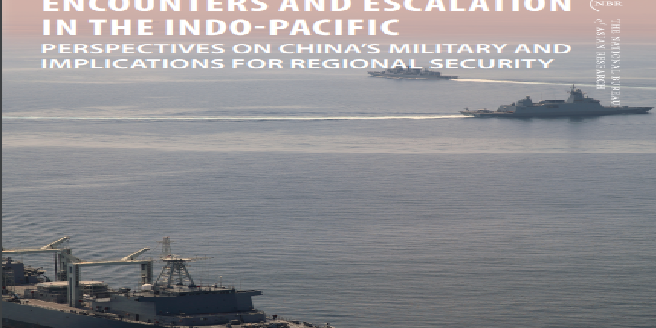Brent Sadler for The Heritage Foundation
KEY TAKEAWAYS
- Since the 1992 departure of U.S. forces from bases in the Philippines, Chinese encroachment and provocations in the South China Sea have increased continuously.
- Creating a visible U.S. naval presence at four key locations could enhance the diplomatic message and bolster the maritime rules-based order.
- The contest over the South China Sea involves more than besting the Chinese Communist Party. It is a competition over whose maritime order will prevail.
Since the 1992 departure of U.S. forces from bases in the Philippines, Chinese encroachment and provocations in the South China Sea have increased continuously.
The lack of U.S. strategic attention and sustained naval presence has opened a maritime governance vacancy that the Chinese Communist Party and its military have gradually filled. Left unchecked, the situation imperils U.S. alliances and trade that have undergirded decades of American prosperity and security.
The Chinese Communist Party has in recent years quickened the pace of its efforts to undermine U.S. security alliances and replace existing international maritime norms with Sino-centric ones. To do this, the Chinese have implemented unilateral fishing bans, harassed local non-Chinese fishermen and strong-armed anyone who dares conduct oil exploration in areas China considers theirs.
To establish control of this sea, the Chinese in 2015completed a massive building campaign that produced an archipelago of fortified man-made island fortresses—breaking a promise to then-President Barack Obama.
Now, once again, a season of crisis is upon us. With spring comes calmer seas and favorable winds in the South China Sea—an ideal time for another round of China’s gray-zone tactics. In the coming months, the Chinese will likely challenge the U.S. again to demonstrate America’s inability to safeguard the
maritime rules-based order. Given the rapidly unfolding war in Ukraine, a potential near-term Chinese crisis presents a conundrum of where to prioritize military force as well as diplomatic capital.
>>> U.S. Navy’s Edge on China Dwindling and Lawmakers Don’t Care
The Chinese Communist Party’s gradual undermining of accepted maritime norms in the South China Sea is often equated to “boiling a frog.” The metaphor suggests a pot where the heat is turned up so gradually that the frog doesn’t notice it until it is too late for it to escape. In this case, the Chinese government is heating up the South China Sea pot, and the frog has been the U.S. In the last 12 months, as President Putin in Russia massed forces and practiced for his invasion of Ukraine, China has been conducting naval and air operations in close proximity to Taiwan in increasingly larger formation.
Reversing Roles
Now there is a chance to reverse roles and boil China’s frog, using very deliberately postured naval forces and diplomacy.
The U.S. could turn the tables on China by deploying a visible naval presence at four key locations in the South China Sea. Paired with clearly articulated diplomacy, these actions could rally regional partners and send a strong message that the U.S. and its partners are not backing down.
Three developments present important markers in the effort for the U.S. and its allies to exert pressure on China to tone down its aggressive posture in international waters.
First was the Philippines’ 2016 win at the Permanent Court of Arbitration (i.e., The Hague) declaring China had no legal basis to claim the totality of the South China Sea. Originally, Philippine President Rodrigo Duterte had set aside this win to lure Chinese investment in his country. When the investment soured, he reversed course in 2020 and began pressing this arbitral win.
Second, statements by then-commander of the U.S. 7th Fleet, Vice Adm. William Merz, and then-Secretary of State Mike Pompeo were timed perfectly during sustained naval presence over the spring and summer months of 2020. These statements signaled support for the legal right of nations in the region, such as Malaysia, to conduct fishing and oil exploration in their own maritime “economic exclusive zones” during a crisis involving a Malaysian-contracted drillship (the West Capella) that was being harassed by Chinese ships. A month’s-long campaign of sustained U.S. diplomatic and naval pressure saw China back off, demonstrating that it can sometimes be compelled to change course.
Third, the January 2022 State Department Limits in the Sea report on China’s South China Sea maritime claims made clear and specific the U.S. legal position regarding the extent of each nation’s exclusive economic zones and territorial waters in the region.
With this in mind, creating a visible U.S. naval presence at four key locations could enhance the diplomatic message and bolster the maritime rules-based order that is key to U.S. interests in the region.
Naval Presence
The U.S. should maintain its first naval presence at Vietnam’s southern exclusive economic zone, which would deter Chinese harassment of Vietnamese oil surveying and extraction. The U.N. Convention on the Law of the Sea and customary international law, which all regional states, including China, have agreed to, grants nations “sovereign rights for the purpose of exploring and exploiting, conserving and managing the natural resources. …” The message to the region would be to uphold economic rights within a rightful exclusive economic zone.
The second naval presence should be near Scarborough Shoal, site of a 2012 dispute between the Philippines and China that drew in the U.S. diplomatically. Naval presence would serve to monitor and ideally deter Chinese militarization of the shoal while highlighting China’s duplicity in not honoring past promises to vacate the shoal. The message to the region would be that the U.S. will not accept coercive or unilateral changes at disputed features.
A third naval presence is needed at Second Thomas Shoal, home to a Philippines outpost and repeated Chinese harassment. The most recent provocation involved three Chinese Coast Guard vessels using water cannons to forcibly turn back Philippine resupply vessels headed to the garrison. This resulted in a rare rebuke from the U.S. that attacks on Philippine government vessels would trigger our Mutual Defense Treaty to defend Philippine forces. Our presence here demonstrates the viability of U.S. security treaties and the unacceptability of China’s interference with another nation’s maritime forces in its own waters.
The U.S. should maintain a fourth naval presence in the vicinity of James Shoal and the North and South Luconia Shoals within Malaysia’s and Indonesia’s exclusive economic zones. This area has been the target of repeated Chinese encroachment, and a U.S. presence would help deter Chinese intimidation of oil survey operations, local fishermen and local nations’ maritime forces. The message to those at sea and regional states is the U.S.- led rules-based maritime order is the best guarantor of their rightful access to an area rich in oil and fish.
Unfortunately, the lack of U.S. strategic attention and sustained naval presence has been exacerbated by the years-long Fat Leonard corruption and bribery scandal involving dozens of U.S. naval officers and sailors in Southeast Asia. This sad saga and ensuing investigations have chilled port visits and engagements in the region for far too long. This situation has conspired to provide the Chinese a decades-long opportunity that they have used to reset the region to their benefit. A course correction is needed and begins with naval presence.
Maritime Gap
Posturing a persistent naval presence this way in the South China Sea requires tradeoffs with today’s limited fleet. Yet, given the strategic importance of this region to China’s ambitions over Taiwan and Asia, it is an investment worth making. Dominance of today’s maritime “Fulda Gap” would posture China’s military for securing southern approaches to Taiwan, complicate U.S. military operations in east Asia and coerce regional partners from supporting U.S. diplomacy. For a Navy that is undersized to meet all security requirements, it is imperative the right mix of forces be placed and sustained for lasting effect in decisive theaters. The South China Sea is one of those decisive theaters where, like pressure points in the martial art Aikido, naval force can enable an economy of force that induces China to change behavior.
>>> Give Taiwan What It Thinks It Needs—Just in Case
Moreover, naval expert Hunter Stires asserts current U.S. approaches have been unsuccessful due to a paucity of naval presence, but also a misreading of the nature of the Chinese challenge. Their objective is to replace the existing maritime rules based order with a Sino-centric one, which Hunter argues is akin to an insurgency at-sea. Meeting this challenge of course requires presence.
In a unique moment of transparency, the executive summary of the Navy’s 2016 Force Structure Assessment revealed that, to meet all peacetime and war plan operational requirements, the Navy would need 459 ships. That number certainly needs to be larger today, given world events and China’s rapidly growing fleet. Should senior U.S. political leaders embrace this reality, naval presence and force sizing priorities will follow suit as internal defense processes align.
The Joint Staff will have to actualize the new political prioritization via global force management. Today, the GFM process is driven by risk calculations of the geographic combatant commands, such as Central Command, responsible for the Middle East. Each command is responsible for ensuring adequate forces for potential war and near-term military objectives in its particular corner of the world. This prejudices force assignments to the detriment of effecting a long-term global competitive strategy. The GFM process will need to be adjusted to recognize we are once again in an era of great power competition, not just discrete regional challenges. Only with political direction and a responsive Joint Staff can the naval presence needed in this decisive theater be sustained in the near term.
The contest over the South China Sea involves more than besting the Chinese Communist Party. It is a competition over whose maritime order will prevail—a contest that has major economic and security implications for all nations of the region as well as the United States.
The maritime order that benefits the most players and that can be firmly secured will prevail. This requires making a compelling value proposition to the people and governments of the maritime states that are in dispute with China. Doing so necessitates more than just naval presence, but that presence is a required first step in restoring confidence in the existing maritime rules-based order—an order that best serves U.S. interests in trade, prosperity and security.
Brent Sadler (@brentdsadler) is a senior fellow for naval warfare and advanced technology at The Heritage Foundation.
Click here to read the original article at The Heritage Foundation.


